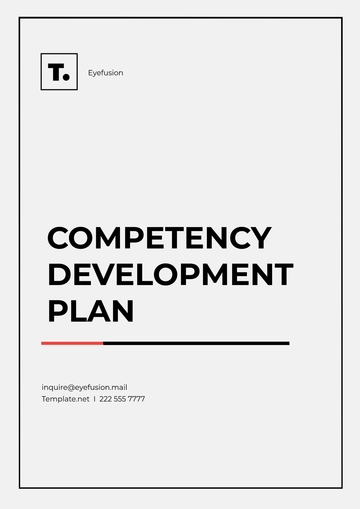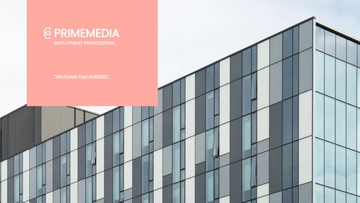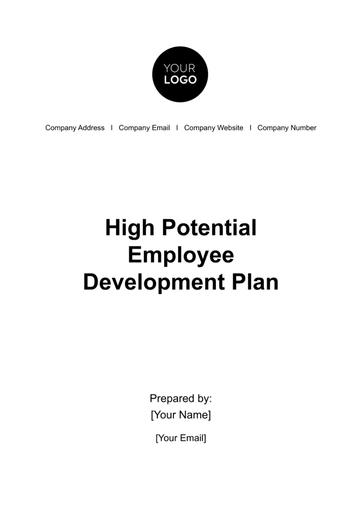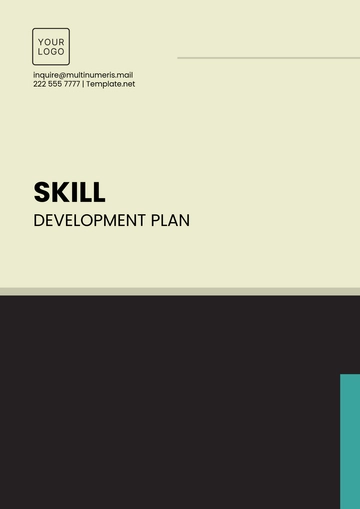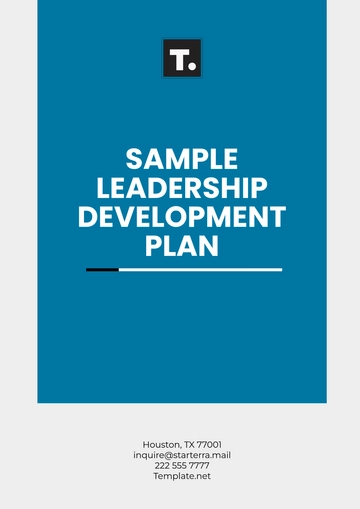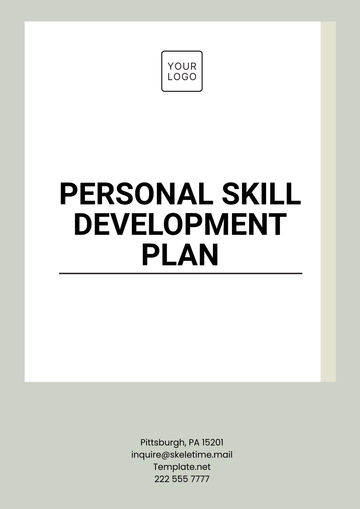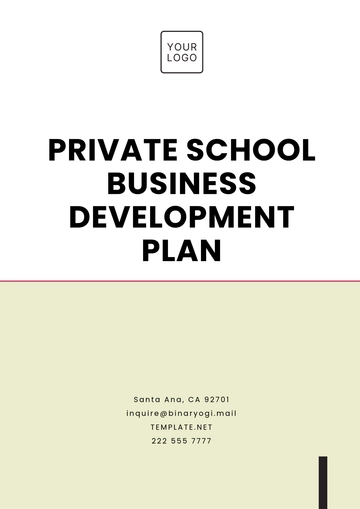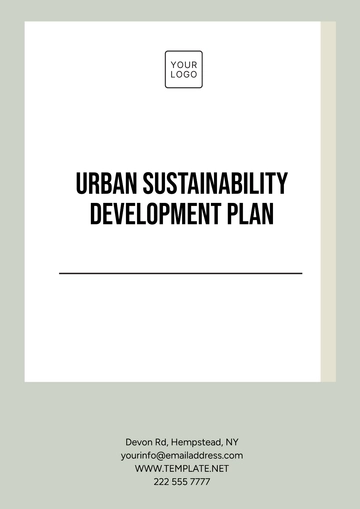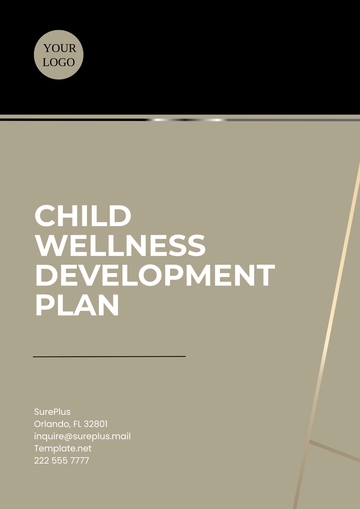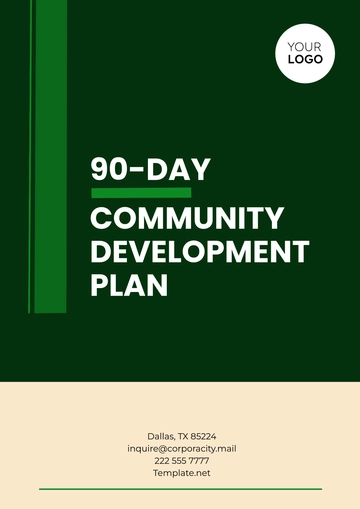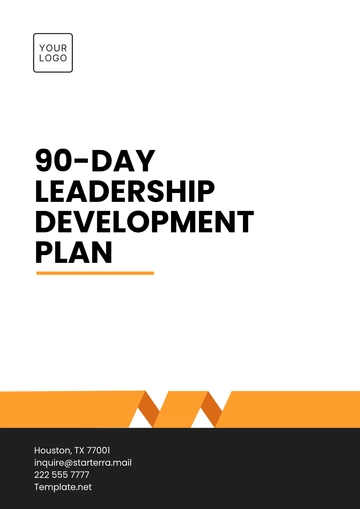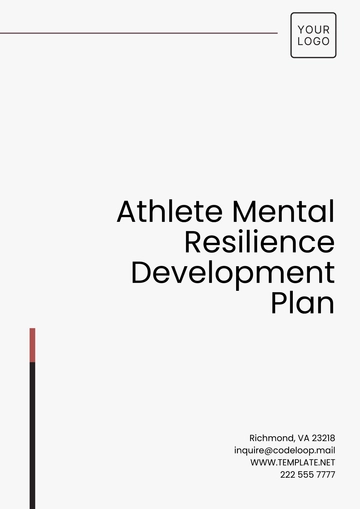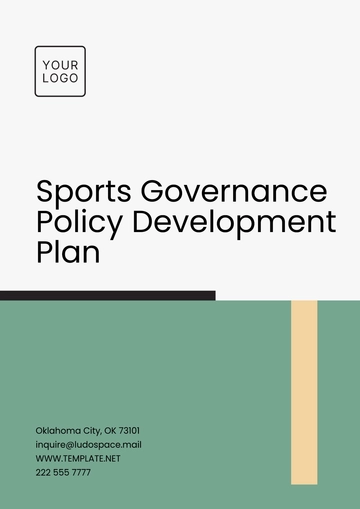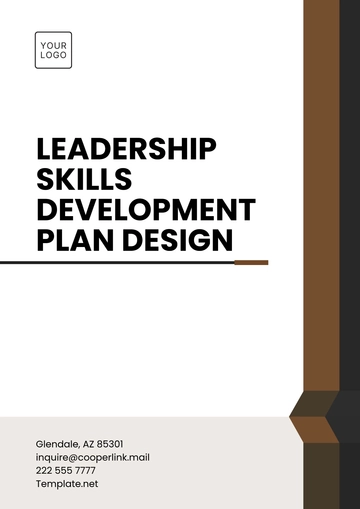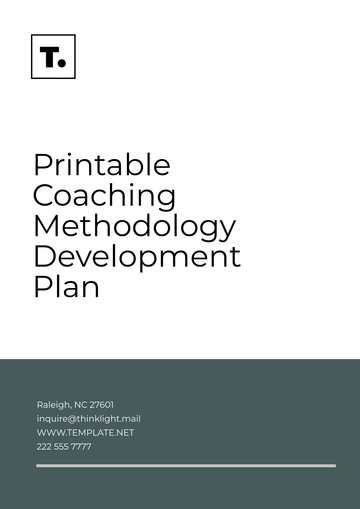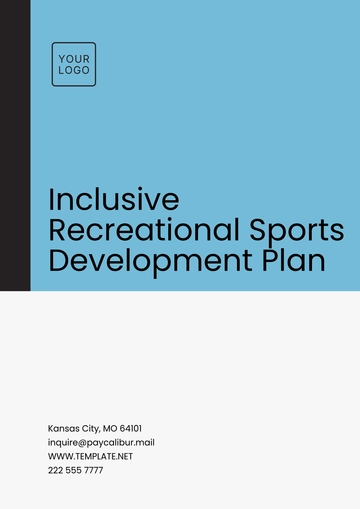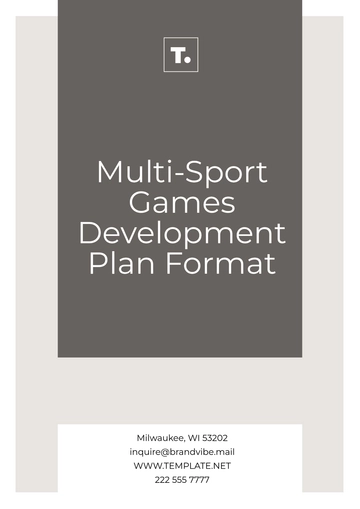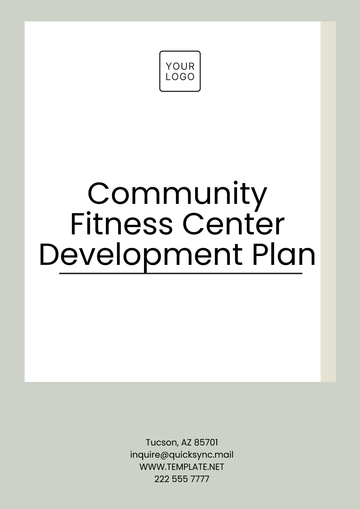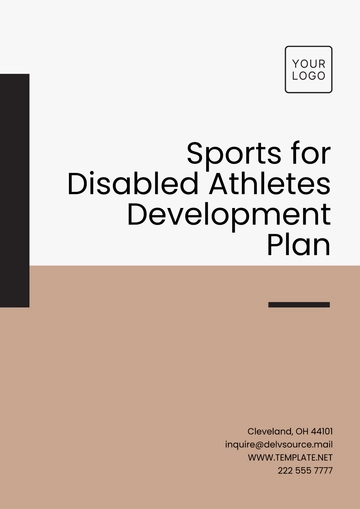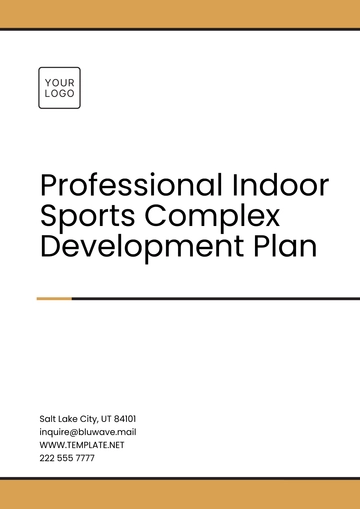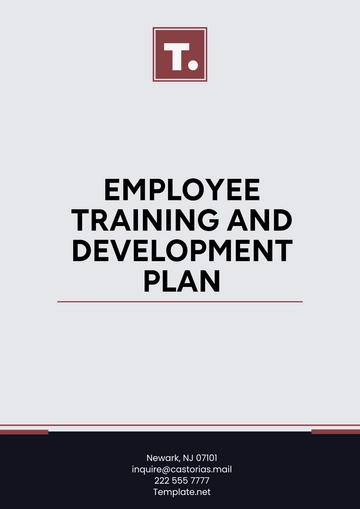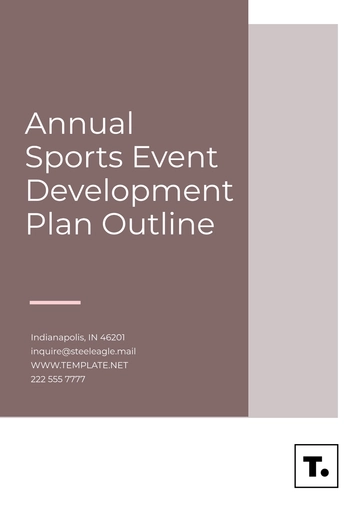Free Real Estate Sustainable Site Development Plan
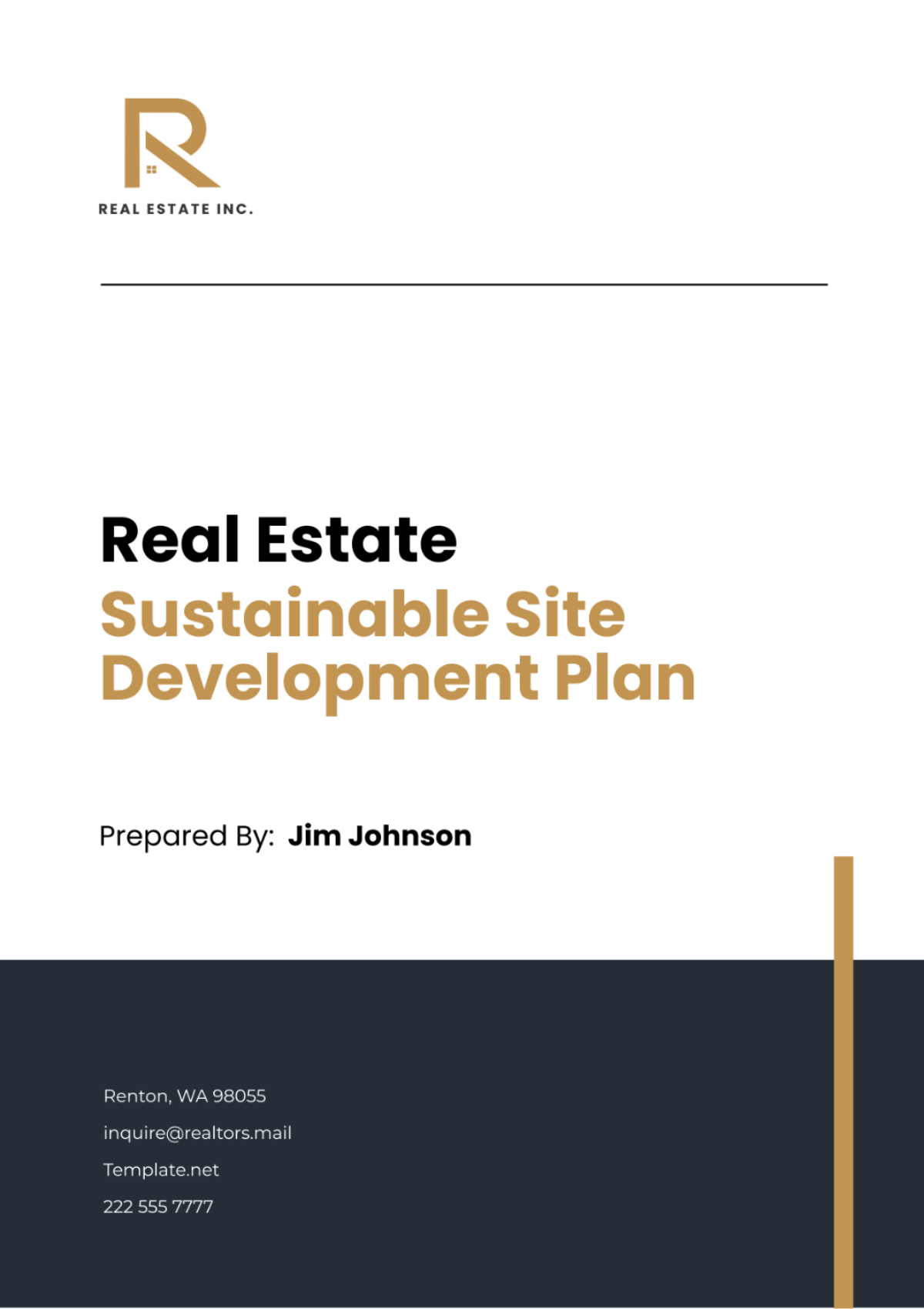
I. Introduction
The purpose of this Sustainable Site Development Plan is to outline [Your Company Name]'s commitment to sustainable and responsible real estate development. This plan will serve as a guide for all our future projects, ensuring that we not only meet but exceed the industry standards for sustainability.
At [Your Company Name], we believe that sustainable development is not just about reducing our environmental impact. It’s about creating healthier, more productive spaces for our occupants, and contributing positively to our communities. This plan outlines our strategies for site selection, design, construction, and operation that align with these goals.
We understand that sustainability is a journey, not a destination. As such, this plan is a living document. It will evolve over time as new technologies emerge, regulations change, and we learn from our experiences. We are committed to continuous improvement and innovation in our pursuit of sustainability.
II. Site Selection
The site selection process is a crucial first step in sustainable development. At [Your Company Name], we prioritize:
A. Location Efficiency
Public Transportation: We aim to choose sites that are close to public transportation. This not only reduces the need for private vehicle use but also promotes a more sustainable and efficient mode of transportation, contributing to reduced carbon emissions.
Amenities and Services: The proximity to amenities and services is also a key factor in our site selection process. By choosing sites near essential services, we can promote a more sustainable lifestyle for the occupants, reducing the need for long commutes.
Walkability: We prioritize sites that promote walkability. This not only contributes to healthier lifestyles but also reduces carbon emissions, aligning with our commitment to sustainability.
B. Preservation of Existing Natural Areas
Conservation: We strive to conserve and integrate existing natural areas into our site design wherever possible. This approach not only preserves the natural beauty of the site but also contributes to the local ecosystem.
Biodiversity: We aim to protect local biodiversity by minimizing disruption to natural habitats. This approach ensures that our developments coexist harmoniously with the local flora and fauna.
Ecosystem Services: We recognize the value of ecosystem services and aim to preserve these through our site selection and design process. This includes services such as air and water purification, climate regulation, and pollination.
C. Brownfield Redevelopment
Regeneration: We see value in regenerating brownfield sites. By turning areas of previous industrial use into valuable real estate, we can contribute to urban regeneration while reducing urban sprawl.
Remediation: We commit to thorough remediation processes to ensure these sites are safe and healthy for future occupants. This includes removing any hazardous materials and improving soil quality.
Community Impact: We consider the potential positive impact on local communities when selecting brownfield sites for redevelopment. This includes job creation, improved infrastructure, and increased property values.
III. Site Design and Development
Once a site has been selected, the design and development phase begins. This is where we start to see our sustainability goals come to life.
A. Stormwater Management
Green Infrastructure: We incorporate green infrastructure such as rain gardens and bioswales into our site design. These features not only manage stormwater on-site and reduce runoff but also contribute to the aesthetic appeal of the site.
Permeable Surfaces: We use permeable surfaces wherever possible. These surfaces allow water to infiltrate into the ground, replenishing local aquifers and reducing the impact on municipal stormwater systems.
Rainwater Harvesting: We explore opportunities for rainwater harvesting. By collecting and reusing rainwater, we can reduce our demand for municipal water supplies and contribute to water conservation.
B. Landscape Design
Native Plantings: We use native plantings in our landscape design. These plants are adapted to the local climate and soil conditions, reducing the need for irrigation and maintenance. They also support local biodiversity by providing habitat for local wildlife.
Heat Island Reduction: We design our landscapes to reduce heat islands. By using shade trees and reflective materials, we can keep our sites cooler, reducing the need for air conditioning and contributing to energy efficiency.
Outdoor Amenities: We provide outdoor amenities for occupants. These spaces encourage interaction with the natural environment, promoting health and well-being.
C. Building Orientation and Design
Solar Orientation: We consider solar orientation in our building design. By maximizing natural light and heat during the winter and minimizing heat gain during the summer, we can reduce energy use and improve occupant comfort.
Energy Efficiency: We incorporate energy-efficient design features such as high-performance windows and insulation. These features not only reduce energy use but also improve the comfort and health of building occupants.
Indoor-Outdoor Connection: We design our buildings to have a strong connection with the outdoors. By providing occupants with views of nature and access to outdoor spaces, we can improve their well-being and productivity.
IV. Energy efficiency
Energy efficiency is a critical aspect of sustainable real estate development. The following table outlines some of the key strategies we employ at [Your Company Name] to enhance the energy efficiency of our developments:
Strategy | Description |
|---|---|
Building Materials and Construction Techniques | Use of materials and construction techniques that enhance the energy efficiency of the building. |
HVAC Systems | Installation of high-efficiency heating, ventilation, and air conditioning (HVAC) systems. |
Renewable Energy Sources | Integration of renewable energy sources, such as solar panels or wind turbines, into the building design. |
A. Building Materials and Construction Techniques
The choice of building materials and construction techniques can significantly influence a building’s energy efficiency. For instance, using insulation materials with high R-values can reduce heat transfer through the building envelope, reducing the need for heating and cooling. Similarly, construction techniques that minimize thermal bridging can enhance the overall energy efficiency of the building. At [Your Company Name], we carefully select our building materials and employ construction techniques that align with our commitment to energy efficiency.
B. HVAC Systems
HVAC systems account for a significant portion of a building’s energy consumption. High-efficiency HVAC systems can reduce this energy use, resulting in lower utility bills and a smaller carbon footprint. At [Your Company Name], we prioritize the installation of high-efficiency HVAC systems in our developments. We also consider factors such as the size and layout of the building, the local climate, and the specific heating and cooling needs of the occupants when selecting and designing these systems.
C. Renewable Energy Sources
The integration of renewable energy sources is another key strategy in enhancing the energy efficiency of our developments. Renewable energy sources, such as solar panels or wind turbines, generate electricity without emitting greenhouse gases. They can also reduce reliance on the grid, providing a reliable source of power even during outages. At [Your Company Name], we assess the feasibility of integrating renewable energy sources into each of our developments, considering factors such as the local climate, the orientation and design of the building, and the available budget.
The importance of energy efficiency in real estate development cannot be overstated. Buildings are responsible for a significant portion of global energy use and greenhouse gas emissions. By enhancing the energy efficiency of our developments, we can contribute to the mitigation of climate change. Furthermore, energy-efficient buildings are not only environmentally friendly but also economically advantageous. They result in lower utility bills for the occupants and may also command higher rental or sale prices.
In addition to these benefits, energy efficiency can also contribute to the health and well-being of building occupants. For instance, high-efficiency HVAC systems can improve indoor air quality by reducing the concentration of pollutants. Similarly, buildings that incorporate natural light and passive solar design can create more comfortable and productive indoor environments. Therefore, at [Your Company Name], energy efficiency is not just about environmental responsibility and cost savings - it’s also about creating better buildings for people to live and work in.
V. Water Efficiency
Water efficiency is a critical aspect of sustainable real estate development. It involves strategies to reduce water use, recycle water, and manage stormwater. The following table outlines some of the key strategies we employ at [Your Company Name] to enhance the water efficiency of our developments:
Strategy | Description |
|---|---|
Indoor Water Use Reduction | Implementation of water-efficient fixtures and appliances to reduce water use indoors. |
Outdoor Water Use Reduction | Use of water-efficient irrigation systems and drought-tolerant landscaping to reduce water use outdoors. |
Water Recycling and Reuse | Systems for collecting and treating greywater or rainwater for reuse. |
A. Indoor Water Use Reduction
Indoor water use can be significantly reduced by implementing water-efficient fixtures and appliances. For instance, low-flow faucets, showerheads, and toilets can reduce water use in bathrooms, while energy-star rated dishwashers and washing machines can reduce water use in kitchens and laundry rooms. At [Your Company Name], we carefully select our fixtures and appliances to ensure they meet or exceed industry standards for water efficiency.
B. Outdoor Water Use Reduction
Outdoor water use can be a significant part of a property’s total water consumption, particularly in areas with hot, dry climates. Water-efficient irrigation systems, such as drip irrigation or smart sprinklers that adjust watering schedules based on weather conditions, can significantly reduce outdoor water use. Additionally, using drought-tolerant plants in landscaping can further reduce the need for irrigation. At [Your Company Name], we design our outdoor spaces with water efficiency in mind, selecting plants and irrigation systems that minimize water use.
C. Water Recycling and Reuse
Water recycling and reuse systems, such as greywater or rainwater harvesting systems, can provide a significant source of water for non-potable uses, such as toilet flushing or irrigation. These systems collect and treat water that would otherwise go to waste, reducing the demand for fresh water. At [Your Company Name], we assess the feasibility of integrating water recycling and reuse systems into each of our developments, considering factors such as the local climate, the design of the building, and the available budget.
Water efficiency is not just about reducing water use. It’s also about managing water resources in a way that is sustainable and resilient. Water-efficient buildings are better equipped to handle periods of drought or water scarcity, making them more resilient in the face of climate change. Furthermore, water efficiency can result in significant cost savings, reducing water bills for building occupants.
Moreover, water efficiency can also contribute to the health and well-being of building occupants. For instance, water-efficient landscaping can contribute to the creation of beautiful, low-maintenance outdoor spaces that enhance the quality of life for occupants. Similarly, the use of water-efficient fixtures and appliances can improve the functionality and comfort of indoor spaces. Therefore, at [Your Company Name], water efficiency is not just about environmental responsibility and cost savings - it’s also about creating better buildings for people to live and work in.
VI. Materials and Resources
The selection of materials and resources plays a significant role in the sustainability of our real estate developments. At [Your Company Name], we are committed to choosing materials that are durable, recyclable, and have a low environmental impact. We also aim to manage our resources efficiently, minimizing waste wherever possible.
A. Waste Management Plan
Construction Waste: We aim to minimize construction waste by planning carefully and ordering only the materials we need. By doing so, we can significantly reduce the amount of waste generated during the construction process. Additionally, we segregate waste on-site for recycling or reuse, which allows us to repurpose materials that would otherwise be discarded.
1.1. Waste Segregation: We segregate waste into different categories such as metals, plastics, and organic waste. This practice facilitates the recycling process and ensures that each type of waste is disposed of in the most environmentally friendly manner.
1.2. Waste Reduction: We aim to reduce waste at the source by ordering only the materials we need and using them efficiently. Efficient use of materials is a key aspect of sustainable construction and can significantly reduce the environmental impact of our projects.
1.3. Waste Recycling: We recycle as much waste as possible, which helps us conserve resources and reduce the amount of waste that ends up in landfills.
Operational Waste: We provide facilities for the segregation and recycling of waste during the building’s operation. This includes facilities for composting organic waste, which can be used to enrich the soil on-site or donated to local community gardens.
2.1. Composting: We provide composting facilities for organic waste. Composting is a natural process that transforms organic waste into nutrient-rich soil, which can be used to support plant growth on-site or in local community gardens.
2.2. Recycling: We provide recycling bins for paper, plastic, metal, and glass. Recycling is a key aspect of waste management and helps us conserve resources and reduce the amount of waste that ends up in landfills.
2.3. Waste Education: We educate occupants about the importance of waste segregation and recycling. Education is a key aspect of waste management and can help foster a culture of sustainability among the occupants.
Deconstruction: At the end of the building’s life, we aim to deconstruct rather than demolish, allowing materials to be separated and reused or recycled. Deconstruction is a more sustainable alternative to demolition as it allows for the maximum recovery of materials.
3.1. Material Reuse: We aim to reuse materials from deconstruction in new construction projects. Reusing materials can significantly reduce the demand for new materials and can help conserve resources.
3.2. Material Recycling: We recycle materials that cannot be reused. Recycling helps us conserve resources and reduces the amount of waste that ends up in landfills.
3.3. Landfill Diversion: We aim to divert as much waste as possible from landfill. Landfill diversion is a key aspect of waste management and helps us reduce the environmental impact of our projects.
B. Material Selection
Sustainable Materials: We prioritize materials that are recycled, recyclable, or sourced from sustainable sources. This includes using timber from certified forests and recycled steel. Using sustainable materials can help us reduce the environmental impact of our projects and can contribute to the conservation of natural resources.
1.1. Recycled Materials: We use materials with a high recycled content. Using recycled materials can help us conserve resources and can contribute to the circular economy.
1.2. Sustainable Timber: We use timber from certified sustainable sources. Using sustainable timber can help us conserve forests and can contribute to the conservation of biodiversity.
1.3. Low-Impact Materials: We choose materials that have a low environmental impact over their lifecycle. Low-impact materials are more environmentally friendly and can help us reduce the carbon footprint of our projects.
Local Sourcing: Where possible, we source materials locally to reduce the carbon emissions associated with transportation. Local sourcing can also support local businesses and can contribute to the local economy.
2.1. Supporting Local Businesses: We aim to support local businesses by sourcing materials locally. Supporting local businesses can help stimulate the local economy and can foster good relationships with local suppliers.
2.2. Reducing Carbon Emissions: By sourcing materials locally, we can reduce the carbon emissions associated with transporting materials long distances. Reducing carbon emissions is a key aspect of sustainable construction and can help us mitigate the impacts of climate change.
2.3. Promoting Sustainable Practices: We aim to promote sustainable practices in the local construction industry by choosing suppliers who share our commitment to sustainability. Promoting sustainable practices can help drive the adoption of more sustainable practices in the construction industry.
Healthy Materials: We choose materials that contribute to a healthy indoor environment. This includes avoiding materials that off-gas harmful chemicals. Using healthy materials can improve the indoor air quality of our buildings and can contribute to the health and well-being of the occupants.
3.1. Low-VOC Materials: We choose materials with low or no volatile organic compounds (VOCs). Low-VOC materials can improve indoor air quality and can contribute to a healthier indoor environment.
3.2. Natural Materials: We use natural materials where possible. Natural materials are often healthier and more environmentally friendly than synthetic materials.
3.3. Healthy Indoor Environment: We aim to create a healthy indoor environment for occupants. A healthy indoor environment can improve the health and well-being of the occupants and can contribute to a more productive and comfortable living or working environment.
C. Resource Reuse and Recycling
Water Recycling: We incorporate systems for the collection and treatment of greywater for reuse in toilets or irrigation. Water recycling can help us conserve water and can reduce our demand for fresh water.
1.1. Greywater Systems: We install greywater systems to collect and treat water from showers, sinks, and washing machines for reuse in toilets or irrigation. Greywater systems can help us conserve water and can reduce our demand for fresh water.
1.2. Rainwater Harvesting: We install rainwater harvesting systems to collect and store rainwater for use in irrigation or other non-potable uses. Rainwater harvesting can help us conserve water and can reduce our demand for fresh water.
1.3. Water-Saving Appliances: We install water-saving appliances and fixtures to reduce water use. Water-saving appliances and fixtures can help us conserve water and can reduce our water bills.
Material Reuse: We aim to reuse materials on-site where possible, such as crushed concrete for use in foundations. Material reuse can help us conserve resources and can reduce the amount of waste that we generate.
2.1. On-Site Material Reuse: We aim to reuse materials on-site, reducing the need for new materials and reducing waste. On-site material reuse can help us conserve resources and can reduce the environmental impact of our projects.
2.2. Material Exchange Programs: We participate in material exchange programs, giving away or selling unused materials to other projects where they can be used. Material exchange programs can help us reduce waste and can contribute to the circular economy.
2.3. Donation of Unused Materials: We donate unused materials to local schools, community groups, or other organizations where they can be used. Donating unused materials can help us reduce waste and can contribute to the local community.
Recycling Facilities: We provide facilities for the collection and storage of recyclable materials. This makes it easy for occupants to recycle, reducing waste and encouraging sustainable behaviors.
3.1. Recycling Bins: We provide clearly labeled recycling bins for different types of recyclable materials. Providing recycling bins can make it easy for occupants to recycle and can contribute to waste reduction.
3.2. Education: We educate occupants about what can be recycled and how to use the recycling facilities. Education can help foster a culture of sustainability among the occupants and can encourage them to recycle.
3.3. Waste Reduction Goals: We set waste reduction goals and monitor our progress towards these goals. Setting waste reduction goals can help us stay focused on our commitment to sustainability and can motivate us to continually improve our waste management practices.
VII. Indoor Environmental Quality
Indoor environmental quality is a crucial aspect of sustainable real estate development. It involves creating indoor environments that are healthy, comfortable, and conducive to the well-being and productivity of occupants. The following table outlines some of the key strategies we employ at [Your Company Name] to enhance the indoor environmental quality of our developments:
Strategy | Description |
|---|---|
Ventilation and Indoor Air Quality | Use of ventilation systems and materials that improve indoor air quality. |
Thermal Comfort | Design and operation of heating, ventilation, and air conditioning (HVAC) systems to ensure thermal comfort. |
Daylighting and Views | Maximize natural light and provide views to the outdoors. |
A. Ventilation and Indoor Air Quality
Indoor air quality is a key component of indoor environmental quality. It can be significantly influenced by the ventilation system used in a building and the materials used in its construction and furnishing. At [Your Company Name], we use ventilation systems that ensure adequate fresh air supply and effective removal of pollutants. We also select materials that do not emit harmful substances into the indoor environment. This approach helps to prevent health problems associated with poor indoor air quality, such as allergies, asthma, and other respiratory conditions.
B. Thermal Comfort
Thermal comfort is another important aspect of indoor environmental quality. It is determined by factors such as air temperature, humidity, air movement, and the temperature of surrounding surfaces, and can be influenced by the design and operation of the HVAC system. At [Your Company Name], we design our HVAC systems to provide a comfortable and stable indoor temperature and humidity level. We also consider the thermal properties of building materials and the building’s orientation and insulation to optimize thermal comfort.
C. Daylighting and Views
Access to natural light and views to the outdoors can significantly enhance indoor environmental quality. They can improve occupants’ mood, productivity, and overall well-being. At [Your Company Name], we use design strategies such as the strategic placement of windows, the use of light shelves, and the selection of window glazing to maximize natural light. We also aim to provide views to the outdoors from all regularly occupied spaces.
The importance of indoor environmental quality in real estate development cannot be overstated. It directly affects the health, comfort, and productivity of building occupants. Buildings with good indoor environmental quality are more pleasant and satisfying places to live and work, which can make them more attractive to potential tenants or buyers. This can translate into higher rental or sale prices, and lower vacancy rates.
Additionally, improving indoor environmental quality can also contribute to sustainability. For example, strategies to improve indoor air quality can also reduce energy use, by reducing the need for mechanical ventilation. Similarly, maximizing natural light can reduce the need for artificial lighting, saving energy. Therefore, at [Your Company Name], enhancing indoor environmental quality is not just about creating better indoor environments - it’s also about contributing to the broader goals of sustainability and energy efficiency.
VIII. Innovation and Design Process
Innovation is at the heart of sustainable development. At [Your Company Name], we are committed to pushing the boundaries of what is possible, exploring new technologies and design approaches to create buildings that are not only sustainable but also innovative and inspiring.
A. Innovative Design Strategies
Integrated Design Process: We use an integrated design process, bringing together architects, engineers, sustainability consultants, and other key stakeholders from the outset. This collaborative approach allows us to explore innovative design solutions and ensures sustainability is considered at every stage of the design process.
1.1. Collaboration: We foster a collaborative environment where all stakeholders can contribute their expertise and ideas. This leads to more innovative and effective design solutions.
1.2. Early Integration: We integrate sustainability considerations from the earliest stages of the design process. This ensures that sustainability is not an afterthought, but a fundamental aspect of our designs.
1.3. Continuous Improvement: We continually refine and improve our design process based on feedback and lessons learned from previous projects. This commitment to continuous improvement drives innovation and excellence in our designs.
Building Information Modeling (BIM): We use BIM to create detailed 3D models of our buildings. This allows us to explore different design options, optimize energy performance, and identify potential issues before construction begins.
2.1. Design Exploration: BIM allows us to quickly and easily explore different design options. This enables us to find the most sustainable and effective solutions for each project.
2.2. Energy Optimization: We use BIM to model and optimize the energy performance of our buildings. This helps us to reduce energy use and carbon emissions.
2.3. Issue Identification: BIM helps us to identify potential issues before construction begins. This can save time and money, and ensure the quality and sustainability of our buildings.
Passive Design Strategies: We explore passive design strategies such as natural ventilation, daylighting, and thermal mass to reduce energy use and improve occupant comfort.
3.1. Natural Ventilation: We design our buildings to take advantage of natural ventilation. This can reduce the need for mechanical cooling, saving energy and improving indoor air quality.
3.2. Daylighting: We design our buildings to maximize the use of natural light. This can reduce the need for artificial lighting, saving energy and creating a more pleasant indoor environment.
3.3. Thermal Mass: We use materials with high thermal mass in our buildings. These materials can absorb and release heat, helping to regulate indoor temperatures and reduce energy use for heating and cooling.
B. Research and Education
Post-Occupancy Evaluation: We conduct post-occupancy evaluations to learn from our projects. This involves collecting data on energy use, water use, and occupant satisfaction, and using this information to inform our future projects.
1.1. Data Collection: We collect data on a range of metrics, including energy use, water use, indoor air quality, and occupant satisfaction. This data helps us to understand the performance of our buildings and identify areas for improvement.
1.2. Learning from Experience: We use the insights gained from post-occupancy evaluations to inform our future projects. This commitment to learning from experience drives continuous improvement and innovation in our designs.
1.3. Sharing Knowledge: We share the findings from our post-occupancy evaluations with the wider industry. This contributes to the collective knowledge and advancement of sustainable design practices.
Industry Collaboration: We collaborate with industry partners, research institutions, and other stakeholders to stay at the forefront of sustainable design. This includes participating in research projects, attending conferences, and sharing our experiences through case studies and presentations.
2.1. Research Projects: We participate in research projects to explore new technologies and design approaches. This helps us to stay at the cutting edge of sustainable design.
2.2. Conferences and Events: We attend conferences and events to learn from others in the industry and share our own experiences. This fosters a culture of learning and collaboration within the industry.
2.3. Case Studies and Presentations: We share our experiences and insights through case studies and presentations. This helps to advance the knowledge and practice of sustainable design.
Staff Training: We invest in training for our staff, ensuring they have the skills and knowledge to deliver sustainable buildings. This includes training on the latest design tools, construction techniques, and sustainability standards.
3.1. Design Tools: We provide training on the latest design tools, including BIM and energy modeling software. This ensures that our staff have the skills to design and deliver sustainable buildings.
3.2. Construction Techniques: We provide training on sustainable construction techniques, such as low-impact construction methods and waste management practices. This ensures that our buildings are constructed in a sustainable and efficient manner.
3.3. Sustainability Standards: We provide training on the latest sustainability standards and certifications. This ensures that our staff are up-to-date with the latest best practices in sustainable design.
IX. Conclusion
In conclusion, this Sustainable Site Development Plan of [Your Company Name] is a comprehensive guide that outlines our commitment to sustainable and responsible real estate development. It details our strategies across various aspects of development, from site selection and design to materials selection and waste management. Our aim is to not only meet but exceed industry standards for sustainability, creating developments that are environmentally friendly, economically viable, and beneficial to the communities they serve.
The strategies outlined in this plan reflect our belief that sustainability is not just about reducing our environmental impact. It’s about creating healthier, more productive spaces for our occupants, and contributing positively to our communities. We understand that sustainability is a journey, not a destination. As such, this plan is a living document. It will evolve over time as new technologies emerge, regulations change, and we learn from our experiences.
We are excited about the journey ahead and are committed to continuous improvement and innovation in our pursuit of sustainability. We believe that through our efforts, we can make a significant contribution to a more sustainable future. We look forward to the opportunities and challenges that lie ahead, and we are confident that with our commitment to sustainability, we can create real estate developments that we can all be proud of.
- 100% Customizable, free editor
- Access 1 Million+ Templates, photo’s & graphics
- Download or share as a template
- Click and replace photos, graphics, text, backgrounds
- Resize, crop, AI write & more
- Access advanced editor
Plan sustainable site developments with our Real Estate Sustainable Site Development Plan Template! This Template.net resource is an editable and customizable solution designed to help you create a sustainable site development plan. With our convenient and intuitive AI Editor Tool, you can easily adapt the template to your unique requirements!
